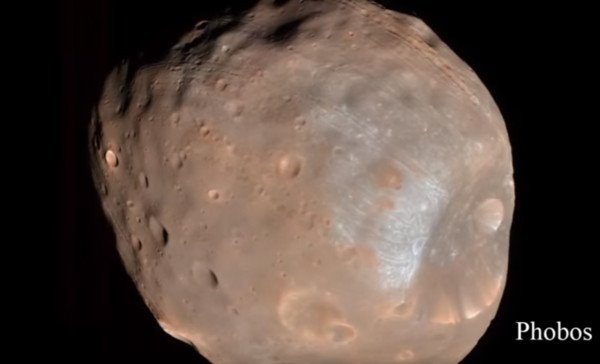(单词翻译:单击)
听力文本
This is Scientific American — 60-Second Science. I’m Lee Billings.
Mars is a planet of outsized splendor. Despite being only half as big and a tenth as heavy as Earth, it bears the solar system’s tallest mountain, longest canyon and largest crater. At 22 and 12 kilometers wide, however, its inner moon Phobos and outer moon Deimos are figurative small potatoes. Scientists suspect both formed much as Earth’s single large moon did, from a massive debris disk ejected into orbit by a giant impact eons ago. But if Mars’s moons formed like Earth’s, why are they so very much smaller?
The answer may be that they did not form alone. New simulations from Pascal Rosenblatt of the Royal Observatory of Belgium and colleagues show how the debris disk from a giant impact on Mars could have generated additional moons a few hundreds of kilometers in size. After forming in the dense inner regions of the disk, those larger moons would have stirred the disk’s sparser outer reaches, allowing smaller companions like Phobos and Deimos to coalesce from the ripples. The study appears in the journal Nature Geoscience.

In this scenario, the reason we only see Phobos and Deimos today is that the bigger moons were destroyed a few million years after their formation. Their low, fast orbits outpaced Mars’s rotation, creating a tidal pull that sent them spiraling down to crash into the planet (Earth’s moon, by contrast, orbited slower than our planet’s rotation, allowing it to spiral outward and survive). Future investigations could test the new hypothesis by looking for clusters of Martian craters produced by the infalling moons, but in the meantime, proof that Mars can kill its companions is right before our eyes: The orbit of Deimos is stable, but Phobos is in a death spiral, losing two centimeters of altitude per year to Mars’s tidal pull. It will plunge into the planet in 20 million to 40 million years, leaving lonely, far-out Deimos as the last vestige of what may have been a once-mighty system of Martian moons.
For Scientific American — 60-Second Science Science. I'm Lee Billings.
参考译文
这里是科学美国人——60秒科学。我是李·比林斯。
火星是一个拥有惊人光辉的行星。虽然火星的体积只有地球的一半,重量只有地球的十分之一,但是它拥有太阳系中最高的山峰、最长的峡谷以及最大的火山口。在22公里和12公里宽处,火星内部卫星火卫一和外部卫星火卫二像生动形象的两颗小土豆。科学家认为,这两颗卫星的形成与地球上形成唯一的月球类似,是亿万年前发生大碰撞时大量碎片被送入轨道而形成。但是如果火星卫星的形成与月球的形成过程类似,那为什么它们的体积会小这么多?
答案或许是它们并不是单独形成的。比利时皇家天文台的帕斯卡尔·罗森布拉特和他的同事进行了模拟试验,目的是说明火星大碰撞产生的碎片盘如何形成几百公里大小的卫星。在碎片盘密集的内区形成以后,较大的卫星会搅动碎片盘的稀松外延,允许火卫一和火卫二这样的小型卫星凝结而成。这项研究发表在《自然地球科学》期刊上。
在这种情况下,我们现在之所以只能看到火卫一和火卫二的原因是,那些较大的卫星在它们形成几百万年后被摧毁。它们在又低又快的轨道运行,速度超过了火星自转,因此而形成的潮汐推动它们盘旋而下,最终撞向火星。(相比之下,月球运行轨道的速度慢于地球自传,使其螺旋向外延展并生存下来。)未来的调查可以通过寻找由陨落卫星形成的火星陨石坑集群,来测试这一新假设,但与此同时,证明火星可以杀死其同伴的证据就展现在我们眼前:火卫二的运行轨道很稳定,但是火卫一处在“死亡螺旋”中,由于火星的潮汐力,火卫一的运行高度每年下降2厘米。在未来二千万至四千万年,火卫一将撞向火星,只留下非常遥远的火卫二,成为曾经辉煌的火星卫星系统的最后遗迹。
谢谢大家收听科学美国人——60秒科学。我是李·比林斯。
译文为可可英语翻译,未经授权请勿转载!
重点讲解
重点讲解:
1. by contrast 相比之下;与…相反;
例句:The private sector, by contrast, has plenty of money to spend.
相比之下,私营部门就有很多钱可供开销。
2. look for 寻找,寻求;
例句:You can look for the book in the library catalogue.
你可以在图书馆的图书目录上查找这本书。
3. in the meantime 在此期间;其间;
例句:In the meantime the sky is turning clear.
与此同时,天空开始晴朗起来。


